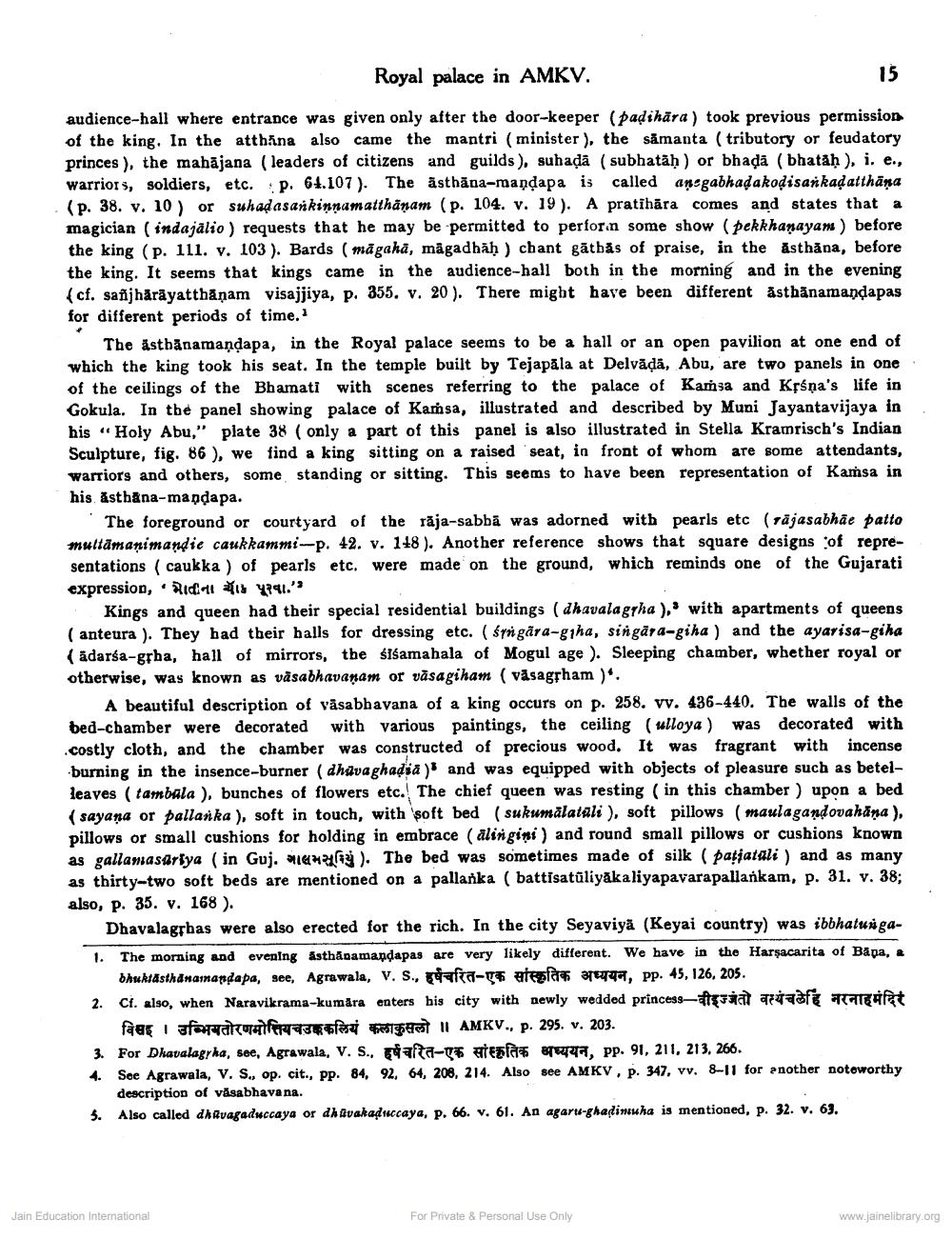________________
Royal Palace in AMKV.
15
audience-hall where entrance was given only after the door-keeper (padihāra) took previous permission of the king. In the atthana also came the mantri (minister), the såmanta (tributory or feudatory princes), the mahājana (leaders of citizens and guilds ), suhada (subhatāḥ) or bhada (bhatåh ), i. e., warriors, soldiers, etc. p. 64.107). The ästhāna-maņdapa is called ancgabhadakodisankadatthāna (p. 38. v. 10 ) or suhadasankinnamatthānam (p. 104. v. 19). A pratihāra comes and states that a magician (indajālio ) requests that he may be permitted to perforin some show (pekkhanayan) before the king (p. 111. v. 103 ). Bards (māgahā, māgadhāh ) chant gātbås of praise, in the asthāna, before the king. It seems that kings came in the audience-hall both in the morning and in the evening (cf. saħjhārāyatthāņam visajjiya, p. 355. v. 20). There might have been different asthānamandapas for different periods of time."
The ästbānamaņdapa, in the Royal Palace seems to be a hall or an open pavilion at one end of which the king took his seat. In the temple built by Tejapāla at Delvādā, Abu, are two panels in one of the ceilings of the Bhamati with scenes referring to the palace of Kamsa and Kļšņa's life in Gokula. In the panel showing palace of Kamsa, illustrated and described by Muni Jayantavijaya in his “Holy Abu," plate 38 ( only a part of this panel is also illustrated in Stella Kramrisch's Indian Sculpture, fig. 86 ), we find a king sitting on a raised 'seat, in front of whom are some attendants, warriors and others, some standing or sitting. This seems to have been representation of Kamsa in his asthāna-mandapa.
The foreground or courtyard of the rāja-sabbā was adorned with pearls etc (rajasabhāe patto multāmanimandie caukkammi-p. 42. v. 148). Another reference shows that square designs of representations (caukka) of pearls etc. were made on the ground, which reminds one of the Gujarati expression, aid11 4791."
Kings and queen had their special residential buildings (dhavalagrha ),' with apartments of queens ( anteura ). They had their halls for dressing etc. (śrngära-giha, singära-giha) and the ayarisa-giha (adarśa-grha, hall of mirrors, the sisamahala of Mogul age ). Sleeping chamber, whether royal or otherwise, was known as väsabhavanam or väsagiham (vāsagrham).
A beautiful description of vasabhavana of a king occurs on p. 258. vv. 436-440. The walls of the bed-chamber were decorated with various paintings, the ceiling (ulloya) was decorated with costly cloth, and the chamber was constructed of precious wood. It was fragrant with incense burning in the insence-burner (dhava ghadia)" and was equipped with objects of pleasure such as betelleaves (tambala ), bunches of flowers etc. The chief queen was resting ( in this chamber) upon a bed (sayang or pallanka ), soft in touch, with soft bed (sukumälatali ), soft pillows (maulagandovahāna ), pillows or small cushions for holding in embrace (alingini) and round small pillows or cushions known as gallaniasarlya (in Guj. 423). The bed was sometimes made of silk (patjatali ) and as many as thirty-two soft beds are mentioned on a pallanka (battisatöliyak aliyapavarapallankam, p. 31. v. 38; also, p. 35. v. 168 ).
Dhavalagrhas were also erected for the rich. In the city Seyaviya (Keyai country) was ibbhatunga1. The morning and evening Asthanamandapas are very likely different. We have in the Harsacarita of Bapa, a
Shuklasthanamandapa, see, Agrawala, V. S., fta- etrafa s a , pp. 45, 126, 205. 2. Cl. also, when Naravikrama-kumara enters his city with newly wedded princess- Fit Triaaf PIERRE
faar afwarcraferentesi TI AMKV., p. 295. v. 203. 3. For Dhavalagyha, see, Agrawala, V. S., afta-Tu tepla s , pp. 91, 211, 213. 266. 4. See Agrawala, V. S., op. cit., pp. 84, 92, 64, 208, 214. Also see AMKV, p. 347, vv. 8-11 for another notoworthy
description of vasabhava na. 5. Also called dhavagaduccaya or dhavakad uccaya, p. 66. v. 61. An agart-ghadinuha is mentioned, p. 32. v. 63.
tala of Mogul este si singara-gimas, apartments of
Jain Education International
For Private & Personal Use Only
www.jainelibrary.org




